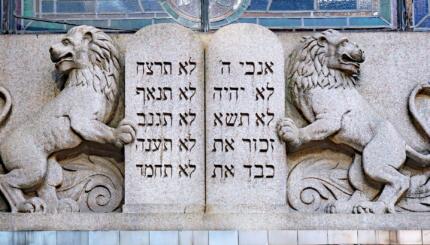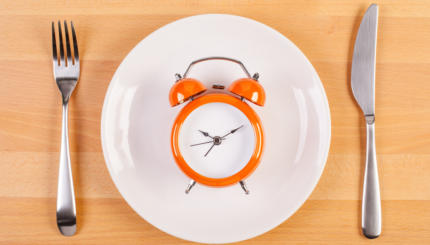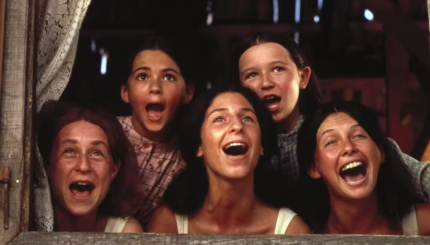This article is excerpted from Celebration and Renewal: Rites of Passage in Judaism (Jewish Publication Society), and is reprinted with permission.
The terms “celebration”and “renewal” reflect Judaism’s positive perspective on the unending circle of life from conception through death and back again to life through the continuity of the generations. Even at the close of a period of mourning, one Jew says to another, “Af simchas“–let us come together again at times of joy. Just after a baby boy undergoes the pain of circumcision, the tension in the room is often released in laughter as the person who names the baby, most often the mohel (ritual circumciser), wishes his parents the joy of bringing their son to the wedding canopy.
What might easily be construed as a ludicrous blessing for an eight-day-old infant actually reflects a communal orientation filled with hope. The ritual belongs not only to the life story of those in the child’s immediate family; it also reminds those present of similar ceremonies held at far-off times and places as well as of other birth ceremonies that they themselves have attended. Thus this moment links them to other Jews across space and time, tying their personal history with that of the Jewish people.
The great French sociologist Emile Durkheim wrote about the importance of public ritual life for maintaining and strengthening group norms. He noted, for instance, that many people feel cheated when a bride and groom elope. Look around at a wedding ceremony and you will see couples reliving their own special moments. They may even mouth the words of the wedding formula or of
With your help, My Jewish Learning can provide endless opportunities for learning, connection and discovery.
the seven benedictions. It is the ritual familiarity of the ceremony that enhances its power. The very routineness of the passage infuses it with communal and historical meaning for the celebrants, while at the same time reinforcing memories of similar moments in the lives of the congregation. Understanding this aspect of human nature–the need to affirm family continuity within a public context–the rabbis ordained that life’s passages be marked in the presence of a quorum, the minimum definition of community. For this reason, circumcision, marriage, and kaddish [recited by mourners] require the presence of a minyan.
The Fundamentally Democratic Nature of Life Cycle Ritual
In addition to connecting the communal and private histories of spectators and participants, life cycle rituals mark significant life stages experienced by most human beings. These rituals, then, represent the most democratic of ceremonials: They are the great levelers. The rabbis demonstrated their understanding of such universality when they wrote in the Talmud (Moed Katan 27a-b) that rich and poor alike should be buried on the simplest of biers in plain shrouds. Like the Amish code, the rabbinic message conveyed the sense that “plain” is the highest accolade. Thus the rabbis affirmed the right of all members of society publicly to mark life cycle events with honor, regardless of social class, gender or intellectual achievement.
The commandments recited in every morning service from [the rabbinic texts] Mishnah Peah 1:1 and Shabbat 127a–that every Jewish community band together to dower poor brides, house travelers, visit the sick, and escort the dead to the grave–exemplify the democratic nature of these rituals. In reality, of course, there was always some differentiation between rich and poor, not in the rituals themselves but in the ceremonies that accompanied them. In late medieval and early modern times, rabbis in some communities even had to invoke sumptuary laws restraining ostentation. Nevertheless, the fundamentally egalitarian nature of life cycle rituals continued, inhering in their universal availability to the community.
Biological Passages and Social Inventions
Some life cycle events, such as birth, puberty, illness, and death, mark passages that are biologically determined, whereas others, such as adolescence, marriage, divorce, and midlife, owe more to social invention. Over time, however, these differentiations may disappear as social convention gains precedence over biological determinism. For example, the fact that the legal status of Bar and Bat Mitzvah originally marked the onset of puberty has become irrelevant to their celebration now; but even so, the attempt by the Reform movement to replace them with Confirmation at age eighteen and later sixteen proved unsuccessful.
Within Jewish law these legal marking-off points were in fact always fixed to a certain age regardless of the physical maturity of an individual child (thus a girl reaches majority at age 12 or the appearance of two pubic hairs), suggesting that there was always a sociological as well as a biological definition of reaching the age of responsibility for fulfilling the commandments.
The Question of Universal Passages: The Necessity and Inevitability of Change
Theoretically, all Jews are entitled to celebrate most public ritual ceremonies. Therefore, those who have been single and/or childless and thus unable to participate in those ceremonies and rituals linked to marriage and parenting–and for young men, Bar Mitzvah–have themselves felt cheated while often being pitied by the community. Precisely because every Jew felt entitled to participate in such events, those who missed out often suffered a profound sense of deprivation. For women, the absence of rituals surrounding marriage and childbearing, with their accompanying statuses of wife and mother, led to feelings of isolation and loss. Until our own century, the lack of a “coming of age” ceremony for girls such as the Bat Mitzvah must have created some feelings of exclusion. Some men whose thirteenth birthdays were ignored have felt the lack of this ceremony all their lives. Thus we sometimes read of elderly Jewish men staging lavish Bar Mitzvah ceremonies for themselves. (Armand Hammer was planning one just before he died.)
Today, assumptions about the natural progression and inevitability of life cycle passages, particularly those based on the traditional nuclear family, serve to distance some Jews from the community rather than bringing them closer to it. Many contemporary Jewish families are not conventional in structure and may feel that they do not “fit” into the community with its traditional institutions and rituals. Divorced parents and stepparents may feel uneasy at a Bar or Bat Mitzvah or their children’s wedding ceremonies. Never-married singles and single parents may avoid certain communal occasions. All this is further compounded in the case of a mixed marriage or remarriage. Even when a spouse, parent, or stepparent converts to Judaism, the fact that the extended family does not follow suit means that whole sets of relatives, including grandparents or mothers- and fathers-in-law, may not relate to important Jewish rituals.
Life cycle rituals are continually evolving to suit new social roles; if they fail to do so, then over time they cease to be the democratic constants that have always undergirded the Jewish community. Of course, this process requires that the richness of tradition and the historical and familial associations embedded in the rituals be balanced with the need for change. Living as we do in an age of transition, we will probably see many innovations tried but only a few retained as integral to the living tradition.
Rela M. Geffen is President of Baltimore Hebrew College and is on the editorial advisory committee of Sh’ma magazine.
Mishnah
Pronounced: MISH-nuh, Origin: Hebrew, code of Jewish law compiled in the first centuries of the Common Era. Together with the Gemara, it makes up the Talmud.
Shabbat
Pronounced: shuh-BAHT or shah-BAHT, Origin: Hebrew, the Sabbath, from sundown Friday to sundown Saturday.
Talmud
Pronounced: TALL-mud, Origin: Hebrew, the set of teachings and commentaries on the Torah that form the basis for Jewish law. Comprised of the Mishnah and the Gemara, it contains the opinions of thousands of rabbis from different periods in Jewish history.


